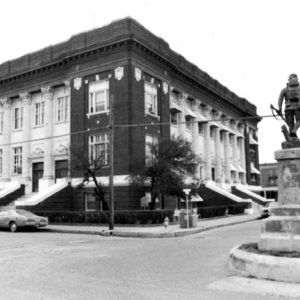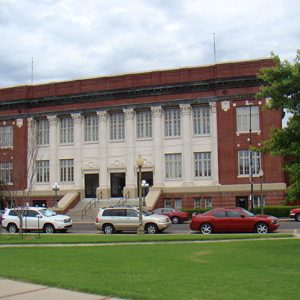calsfoundation@cals.org
Phillips County Courthouse
The Phillips County Courthouse, located at 622 Cherry Street and completed in 1915, is in the heart of downtown Helena-West Helena (Phillips County). The Arkansas Historic Preservation Program recognizes the three-story building as architecturally and historically significant for its local standing and as the best example of the Classical Revival architecture in Phillips County. It was listed on the National Register of Historic Places on July 5, 1977. It stands in the Cherry Street Historic District.
Located in what was once the city of Helena (which merged with the later city of West Helena in 2006), the old Phillips County Courthouse was built in 1869. The two-story building with a bell tower cost over $44,000. In 1911, Phillips County decided to replace it with a modern county courthouse and jail. The Quorum Court appropriated $10,000 for the project, an insufficient amount for a new facility. The county turned to the federal government, eventually gaining a congressional appropriation of $250,000. This presumably happened due to the efforts of Robert B. Macon, the outgoing congressman of Arkansas’s First Congressional District, who was denied re-nomination in the 1912 elections. Macon was from Helena and practiced law there after leaving Congress.
In July 1913, Frank W. Gibb of Little Rock (Pulaski County) completed his design of the building. L. R. Wright and Company of Dallas, Texas, built the courthouse, and construction was completed on June 14, 1915. The two entrances on the northern and eastern façades feature striking Corinthian columns that are painted white. They are built into matching white walls that stand as a stark contrast to the largely maroon-colored brick building. Other Classical features include a decorative frieze and elevated entrances.
The present courthouse stands on a different site than the 1869 building. Once the new Classical building was completed, the county razed the old courthouse and put a public playground on the site.
The most prominent legal case heard in the courthouse was likely the series of trials following the Elaine Massacre, the bloodiest race riot in Arkansas history. In October 1919, Phillips County moved 285 inmates, all African American, into the county jail that stood at that time at the eastern façade of the courthouse. (The jail has since been moved offsite.) Phillips County deputies tortured many of the inmates inside, and prosecutors ultimately charged 122 people, all African American, with various crimes. Phillips County Judge J. M. Jackson presided over the trial and appointed white attorneys for the defendants. The famous Elaine Twelve received death sentences at the Phillips County Courthouse but ultimately were released due to controversial errors in the trial.
The courthouse has undergone some changes since that notorious trial, including the addition of a second courtroom across from the circuit court. However, the building still maintains its historical integrity. Brass and wood moldings still make up the interior of the building, along with decorative plaster ceilings and marble wainscoting.
The streets outside the courthouse were originally built of red brick that matched the building. They were later paved with asphalt, except for a nearby intersection where a bronze World War I memorial statue, called The Spirit of the American Doughboy, stands on a concrete pedestal. It was listed on the National Register of Historic Places on May 23, 1997.
For more information:
Gill, John Purifoy, and Marjem Jackson Gill. On the Courthouse Square in Arkansas. N.p.: 1980.
“Phillips County Courthouse.” National Register of Historic Places nomination form. On file at Arkansas Historic Preservation Program. Online at http://www.arkansaspreservation.com/National-Register-Listings/PDF/PH0007.nr.pdf (accessed October 22, 2020).
Jared Craig
Arkansas Historic Preservation Program








Comments
No comments on this entry yet.